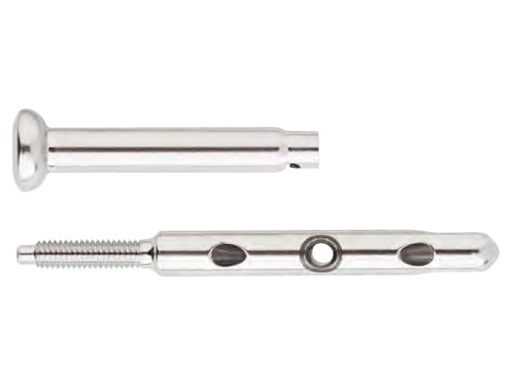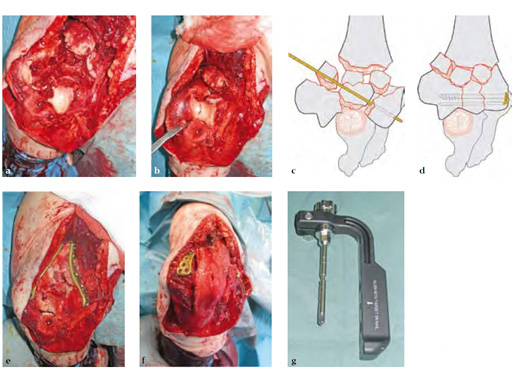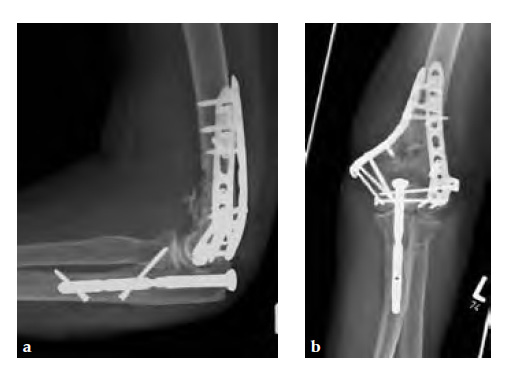
Olecranon Osteotomy Nail
Comminuted articular distal humerus fractures often require a large access area for anatomical reduction of the joint surface and the metaphyseal area. In these cases an olecranon osteotomy is often performed for better visualization of the fracture area, allowing the tip of the olecranon and the triceps muscle to be moved out of the way. After reconstruction of the distal humerus, the olecranon is usually fixed with two K-wires inserted longitudinally down the ulna combined with a tension band in a figure-of-eight. Alternatively, a 6.5 mm cancellous screw with or without tension band is used. Complication rates after refixation of the olecranon have been described in up to 20% of cases. Typical complications are K-wire migration, prominence of implants requiring secondary operation for removal, loss of fixation especially in osteoporotic bone, increased fracture gaps, and nonunions. In addition, cancellous screws may toggle in the canal causing misalignment at the articular surface, leaving gaps or steps. A high reoperation rate has been reported in the literature. Similar complications have been described in olecranon fractures treated with cerclage wires or cancellous screws.
The olecranon osteotomy nail is indicated to treat simple olecranon fractures and osteotomies of the olecranon. The system enables preosteotomy implant insertion ensuring anatomical alignment and easy fixation of the olecranon osteotomy after distal humerus surgery. The set consists of one single nail, one single end cap, and a range of 2.7 mm screws with a threaded head.
The nail is inserted through a triceps tendon longitudinal split of approximately 1 cm. The entry portal is predrilled and the distal part of the nail is inserted at a position distal to the location of the osteotomy using an insertion handle. The implant is cross locked prior to creating the osteotomy. After the distal humerus is fixed, the osteotomized tip of the olecranon is brought back to its original position and an end cap is inserted through the predrilled hole in line with the nail, reducing the olecranon and creating compression across the osteotomy, ensuring an anatomical reduction/alignment. This procedure allows for a quick and easy realignment and fixation of the olecranon. The locking holes in the distal part of the nail are oblique to each other as well as to the anatomical axis of the ulna. This design prevents the nail from moving within the medullary canal to prevent toggling and ensures anatomical reduction of the olecranon fragment. Targeted locking minimizes the size of the incision. The threaded head of the locking screws sit flush with the surface of the ulna minimizing hardware prominence and soft tissue irritation.
Overall, the olecranon nail system provides more stable fixation with less overall fracture gap motion compared to alternative fixation techniques. Since the implant is inserted prior to the osteotomy, refixation of the olecranon at the end of the procedure is an easy and quick procedure.
A 75-year-old female pedestrian was hit by a car and sustained a 2 open fracture of the distal humerus and an additional pelvic ring fracture.
Case provided by Martin Hessmann, Fulda, Germany
Hazards and labeling
Due to varying countries’ legal and regulatory approval requirements, consult the appropriate local product labeling for approved intended use of the products described on this website. All devices on this website are approved by the AO Technical Commission. For logistical reasons, these devices may not be available in all countries worldwide at the date of publication.
Legal restrictions
This work was produced by AO Foundation, Switzerland. All rights reserved by AO Foundation. This publication, including all parts thereof, is legally protected by copyright.
Any use, exploitation or commercialization outside the narrow limits set forth by copyright legislation and the restrictions on use laid out below, without the publisher‘s consent, is illegal and liable to prosecution. This applies in particular to photostat reproduction, copying, scanning or duplication of any kind, translation, preparation of microfilms, electronic data processing, and storage such as making this publication available on Intranet or Internet.
Some of the products, names, instruments, treatments, logos, designs, etc referred to in this publication are also protected by patents, trademarks or by other intellectual property protection laws (eg, “AO” and the AO logo are subject to trademark applications/registrations) even though specific reference to this fact is not always made in the text. Therefore, the appearance of a name, instrument, etc without designation as proprietary is not to be construed as a representation by the publisher that it is in the public domain.
Restrictions on use: The rightful owner of an authorized copy of this work may use it for educational and research purposes only. Single images or illustrations may be copied for research or educational purposes only. The images or illustrations may not be altered in any way and need to carry the following statement of origin “Copyright by AO Foundation, Switzerland”.
Check www.aofoundation.org/disclaimer for more information.
If you have any comments or questions on the articles or the new devices, please do not hesitate to contact us.
“approved by AO Technical Commission” and “approved by AO”
The brands and labels “approved by AO Technical Commission” and “approved by AO”, particularly "AO" and the AO logo, are AO Foundation's intellectual property and subject to trademark applications and registrations, respectively. The use of these brands and labels is regulated by licensing agreements between AO Foundation and the producers of innovation products obliged to use such labels to declare the products as AO Technical Commission or AO Foundation approved solutions. Any unauthorized or inadequate use of these trademarks may be subject to legal action.
AO ITC Innovations Magazine
Find all issues of the AO ITC Innovations Magazine for download here.
Innovation Awards
Recognizing outstanding achievements in development and fostering excellence in surgical innovation.









